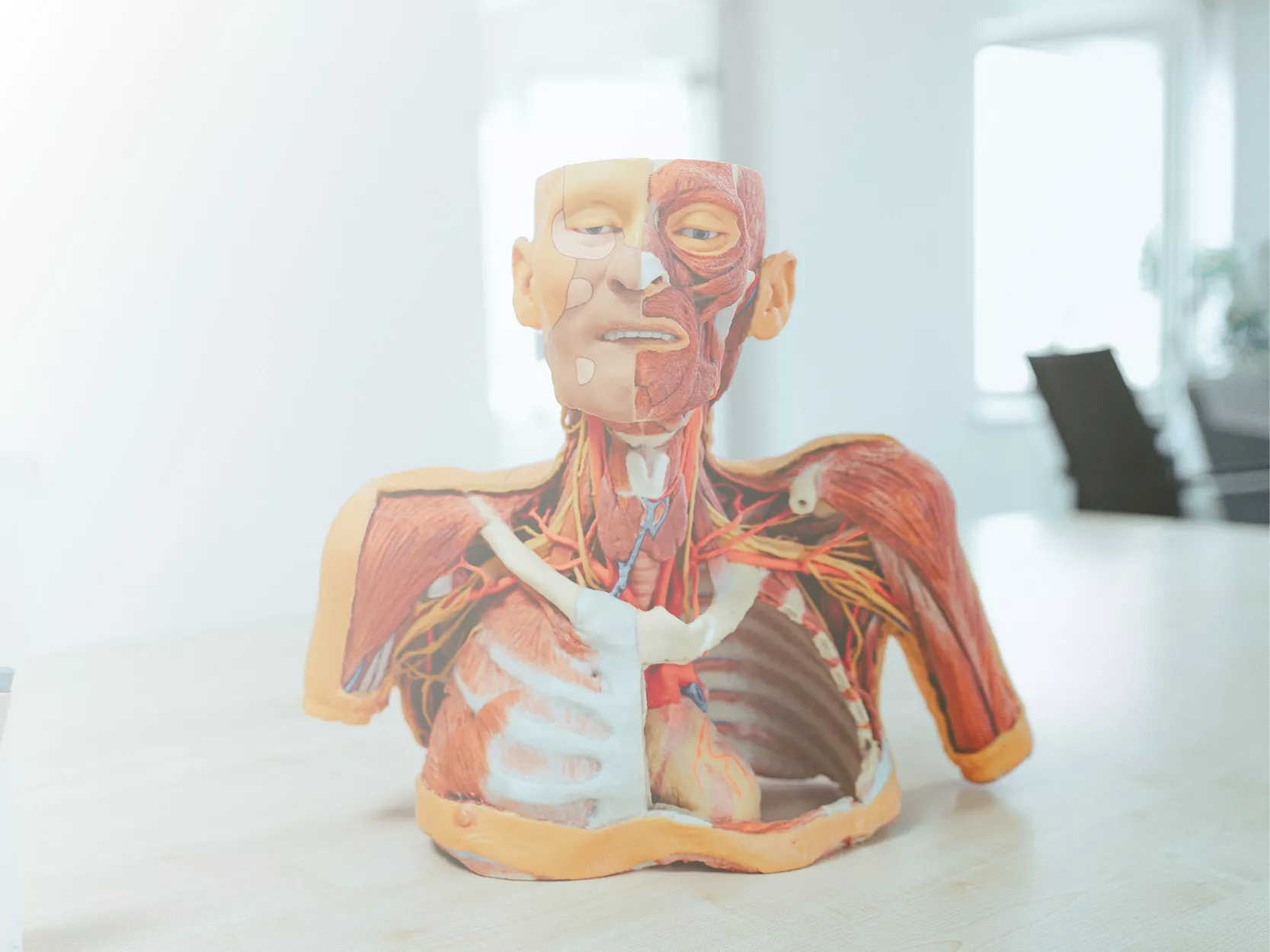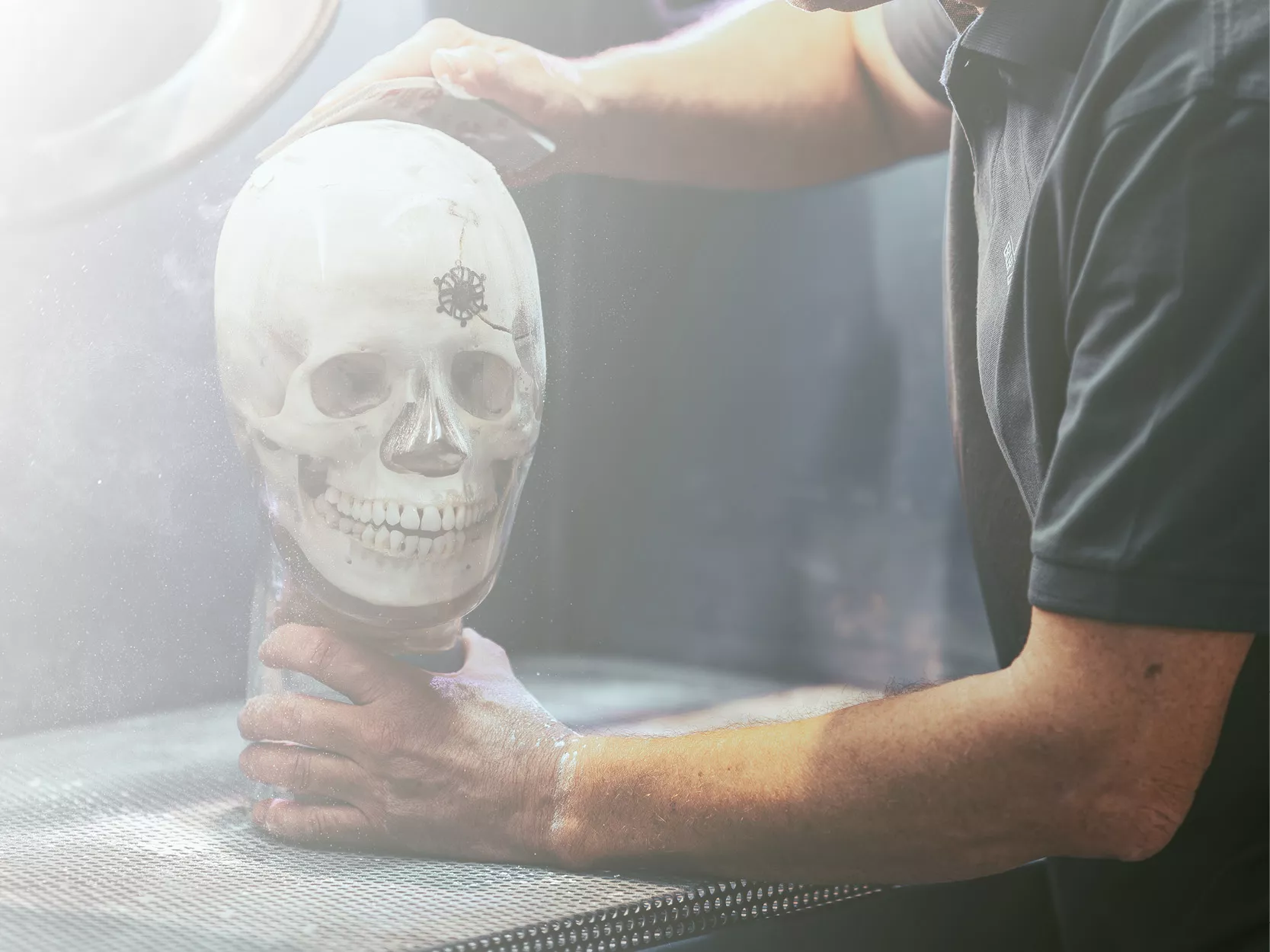Produktinformationen "Superficial Face"
Dieses detaillierte 3D-Modell zeigt eine oberflächliche Präparation der linken Gesichtshälfte direkt vor dem Ohr, wobei wichtige neurovaskuläre Strukturen und Gesichtsmuskeln durch Falschfarben hervorgehoben sind.
Es dient als gezielte Ergänzung zur umfassenderen Präparation in unserem Modell HW 45. Nicht präparierte Bereiche wurden aus Gründen der Übersichtlichkeit digital entfernt.
Wichtigste Merkmale:
Parotisregion und Äste des Gesichtsnervs:
Zeigt die Ohrspeicheldrüse und den Ohrspeicheldrüsengang sowie die Endäste des Gesichtsnervs (CN VII): zervikal, mandibulär, bukkalen, zygomatischen und temporalen.
Gesichtsgefäße und Beziehungen zwischen Nerven und Gefäßen:
Zeigt die Gesichtsarterie und -vene in Bezug auf die Äste des CN VII. Die Gefäße sind vom Unterkiefer bis zur Augenhöhle nachgezeichnet und bieten anatomische Orientierungspunkte.
Mimikmuskeln (hervorgehoben):
Umfasst den Masseter, den Depressor anguli oris, den Zygomaticus major und minor, den Orbicularis oris, den Nasalis, den Levator labii superioris alaeque nasi, den Procerus und den Orbicularis oculi.
Strukturen der Schläfe und Stirn:
Zeigt den Nervus auriculotemporalis und die Arteria temporalis superficialis über der Fascia temporalis, wobei ein Teil des Musculus temporalis sichtbar ist.
Oberhalb davon verlaufen der Nervus supraorbitalis und die Gefäße auf der Aponeurose des Epikraniums und überlagern den Musculus frontalis.
Dieses Modell bietet einen prägnanten und dennoch detailreichen Überblick über die Gesichtsanatomie und eignet sich ideal für die Vermittlung der Beziehungen zwischen Nerven, Muskeln und Gefäßen im oberflächlichen Gesichtsbereich.
Es dient als gezielte Ergänzung zur umfassenderen Präparation in unserem Modell HW 45. Nicht präparierte Bereiche wurden aus Gründen der Übersichtlichkeit digital entfernt.
Wichtigste Merkmale:
Parotisregion und Äste des Gesichtsnervs:
Zeigt die Ohrspeicheldrüse und den Ohrspeicheldrüsengang sowie die Endäste des Gesichtsnervs (CN VII): zervikal, mandibulär, bukkalen, zygomatischen und temporalen.
Gesichtsgefäße und Beziehungen zwischen Nerven und Gefäßen:
Zeigt die Gesichtsarterie und -vene in Bezug auf die Äste des CN VII. Die Gefäße sind vom Unterkiefer bis zur Augenhöhle nachgezeichnet und bieten anatomische Orientierungspunkte.
Mimikmuskeln (hervorgehoben):
Umfasst den Masseter, den Depressor anguli oris, den Zygomaticus major und minor, den Orbicularis oris, den Nasalis, den Levator labii superioris alaeque nasi, den Procerus und den Orbicularis oculi.
Strukturen der Schläfe und Stirn:
Zeigt den Nervus auriculotemporalis und die Arteria temporalis superficialis über der Fascia temporalis, wobei ein Teil des Musculus temporalis sichtbar ist.
Oberhalb davon verlaufen der Nervus supraorbitalis und die Gefäße auf der Aponeurose des Epikraniums und überlagern den Musculus frontalis.
Dieses Modell bietet einen prägnanten und dennoch detailreichen Überblick über die Gesichtsanatomie und eignet sich ideal für die Vermittlung der Beziehungen zwischen Nerven, Muskeln und Gefäßen im oberflächlichen Gesichtsbereich.
Erler-Zimmer
Erler-Zimmer GmbH & Co.KG
Hauptstrasse 27
77886 Lauf
Germany
info@erler-zimmer.de
Achtung! Medizinisches Ausbildungsmaterial, kein Spielzeug. Nicht geeignet für Personen unter 14 Jahren.
Attention! Medical training material, not a toy. Not suitable for persons under 14 years of age.










































